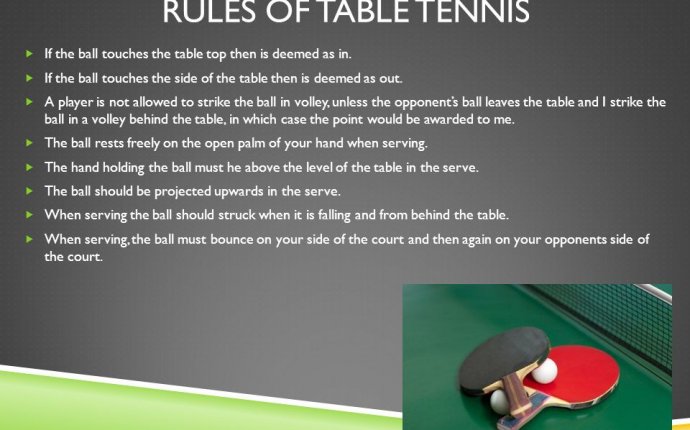
Rules and regulations in Playing table tennis
2017 Table Tennis Rules
| | | | | | |
Recent rule changes appear in italicized font.
Rule 2: Player Eligibility
- All players must check-in with their University or valid government-issued photo IDs with the supervisor prior to participating.
- In singles, members of the Table Tennis sport club must play in the "A" division.
Rule 3: Ground Rules
- A game shall be won by the player/pair first scoring 11 points unless both players/pairs score 10 points. If both player/pairs are tied at 10 points, the game is won by the first player/pair subsequently gaining a lead of two points. The game will be capped at a maximum of 15 points.
- A match shall consist of the best-of-5 games.
- The Championship Match will be played to the best-of-7. Participants are allowed to use a ball agreed upon by both players, otherwise one will be provided for them.
- The winner of a coin toss between opponents shall have choice of serving, receiving, or choice of ends for the first game.
 The loser of the toss shall have the remaining choice.
The loser of the toss shall have the remaining choice. - The players or pairs will alternate serve and side each game.
- A player must allow the ball to bounce before making a play on it.
- If any disagreement occurs in regard to a point, a game, or any other play situation, it shall be mutually agreed by all players in the game that the point or situation be played over immediately.
Rule 4: Order of Play
- Singles: In singles, the server shall first make a good service, the receiver shall then make a good return, and thereafter server and receiver alternately shall make a good return.
- Doubles: The server shall first make a good service, the receiver shall make a good return, the partner of the server shall then make a good return, and the partner of the receiver shall then make a good return, and so on.
Rule 5: Service
- Service shall start with the ball resting freely on the open palm of the server’s stationary free hand.
- The server shall then project the ball near vertically upwards, without imparting spin, so that it rises at least 16cm after leaving the palm of the free hand and then falls without touching anything before being struck.
- As the ball is falling the server shall strike it so it touches first his/her court and then, after passing over or around the net assembly, touches directly the receiver’s court; in Doubles, the ball shall be served cross court from the right side of the service court to the right side of the receiver’s court. In Singles, service is open.
- From the start of the service and until it is struck, the ball shall be above the level of the playing surface and behind the server’s end line, and it shall not be hidden from the receiver by any part of the body or clothing of the server or his/her doubles partner.
- In order for the serve to be legal, it cannot bounce twice on the server’s court.
- A let shall be called during the service if the ball, in passing over or around the net assembly, touches it, provided the service is otherwise good or the ball is obstructed by the receiver or his partner. There is no limit on how many lets may occur successively.
Rule 6: Return
- The ball, having been served or returned, shall be struck so that it passes over or around the net assembly and touches the opponent’s court, either directly or after touching the net assembly.
Source: recserv.uiowa.edu









